Mastering the Software Coding Process: A Comprehensive Guide
The software coding process is where design documents become actual software. This phase involves writing, testing, and integrating code to ensure the software functions as intended. Mastering this process is key to building high-quality applications. In this guide, you’ll learn about the stages, best practices, and common challenges developers face in the software coding process.
Key Takeaways
-
The software coding process is crucial in the development life cycle, focusing on transforming design documents into functional, high-quality code.
-
Key stages of the coding process include setting up the development environment, writing code while adhering to best practices, and integrating code to ensure smooth functionality across software modules.
-
Effective coding practices such as embracing clean code principles, conducting regular code reviews, and prioritizing automated testing are essential for maintaining high code quality and adaptability to changing requirements.
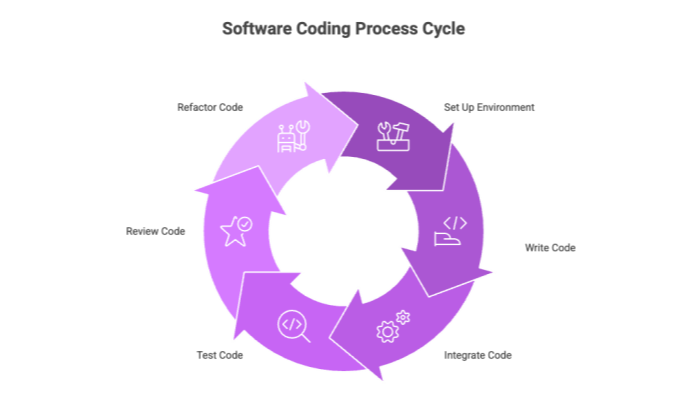

What is the Software Coding Process?
The software coding process, also known as the programming phase, is where design documents are transformed into functional code using various programming languages. This phase is crucial in the software development life cycle as it lays the foundation for the software’s operational capabilities and overall quality. During this phase, developers focus on creating error-free programs that fulfill the intended functionalities outlined in the design. A structured approach is essential to ensure that the software is developed efficiently and meets predefined requirements.
Understanding the software coding process is fundamental to mastering a software development approach. A structured approach ensures that the developed software is efficient, effective, and meets the needs of users and stakeholders. This phase is not just about writing code but about creating a robust and maintainable software system that can evolve with changing requirements and technologies.
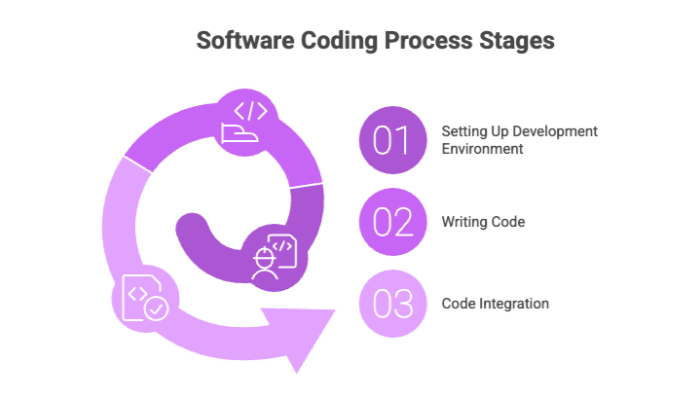

Key Stages in the Software Coding Process
The software coding process involves a series of systematic steps designed to ensure effective development and integration of custom software and software design, including the creation of a software program. These software development processes and software development methodologies are crucial for transforming design documents into functional software that meets user requirements.
The key stages in this process include setting up the development environment, writing the code, and integrating the code into the main software application during the development cycle and development phase.
Setting Up the Development Environment
Setting up the development environment is the first step in the software development process. This involves selecting the appropriate tools, Integrated Development Environments (IDEs), and libraries that are pivotal for the coding phase. Selecting the appropriate tools and libraries streamlines the coding process and enhances productivity. Common IDEs include IntelliJ IDEA for Java development, Visual Studio Code for general purposes, and Xcode for Apple platform applications.
A well-configured development environment can significantly impact the efficiency and effectiveness of the coding process. IDEs offer features like:
-
debugging tools
-
automated build processes
-
integration with version control systems These features are essential for maintaining code quality and managing changes.
A robust production environment development model ensures a smooth transition from design to coding, leading to high-quality software applications and developing software in the software industry, with further development enhancing the overall process and adopting an agile model.
Writing Code
Writing code is at the heart of the software development process. This phase involves not only the initial writing of code but also ongoing testing and debugging to ensure functionality. Maintaining code quality is crucial during this stage, and developers must employ best practices to enhance readability and functionality. Effective coding practices ensure that the software developed is robust, efficient, and maintainable.
During the writing phase, developers need to focus on:
-
Creating clean, efficient, and maintainable code
-
Adhering to coding standards
-
Using meaningful names for variables and functions
-
Organizing code in a logical manner
Prioritizing code quality from the outset reduces the likelihood of bugs and makes the software easier to maintain and extend in the future.
Code Integration
Code integration is a critical phase in the software development process. The system integration phase aims to verify that software modules function together effectively. Its goal is to create a cohesive system. This involves integrating the code into the main software application and ensuring that all components function correctly together. Version control systems are essential for managing changes and integrating code into the main software application.
Continuous integration practices help in seamlessly integrating new code into production without disrupting services. These agile processes ensure that code changes are tested and integrated regularly, reducing the risk management of conflicts and making it easier to identify and fix issues early.
Continuous integration helps development teams maintain high code quality and ensures the software remains stable and functional throughout the development process.

Best Practices for Effective Coding
To maintain high coding standards and adapt to changing requirements, continuous improvement practices are essential. Incorporating these practices fosters a culture of quality coding and innovation, increasing overall efficiency and adaptability.
Best practices for effective coding include embracing clean code principles, implementing regular code reviews, and prioritizing automated testing.
Embrace Clean Code Principles
Writing clean, efficient, and maintainable code is essential for successful software development. High-quality, clean code is characterized by:
-
Readability
-
Maintainability
-
Documentation
-
Adherence to coding standards
-
Meaningful naming
-
Logical organization
Modularity enhances software scalability and allows for easy expansion or modification. Dividing code into smaller, independent parts facilitates better management and maintenance.
Establishing coding standards is crucial for maintaining consistency, readability, and efficiency in codebases. Using clear and meaningful names for functions and variables enhances code clarity and maintainability. Embracing these principles ensures that code is functional, easy to understand, and modify, leading to more efficient and effective software development.
Implement Regular Code Reviews
Code reviews are essential for ensuring code quality and promoting best practices throughout the development process. Key aspects include:
-
Structured code reviews foster collaboration and help identify potential issues early in the development process.
-
Welcoming feedback during code reviews is key to growth and can greatly enhance code quality. Incorporating code review feedback time can streamline this process.
-
Feedback loops facilitate continuous learning by allowing development teams to reflect on previous work and enhance future iterations. Additionally, engaging in a code review can further improve the overall quality of the code.
During code reviews, developers should assess clarity, efficiency, maintainability, and adherence to coding standards. Managing technical debt effectively requires regular code reviews and refactoring to maintain code quality. Regular code reviews ensure that code meets high standards and is continuously improved over time.
Prioritize Automated Testing
Automated testing plays a crucial role in identifying and fixing bugs while ensuring functionality and quality standards. The significance of automated tests lies in its ability to ensure reliability and quality, safeguarding against bugs. Automated testing allows for continuous integration of new code, improving reliability and reducing the risk of introducing bugs.
The drive for speed in development can compromise code quality if not balanced with thorough unit testing and quality assurance practices. Prioritizing automated testing helps maintain high code quality and ensures the software remains robust and reliable throughout the development process.
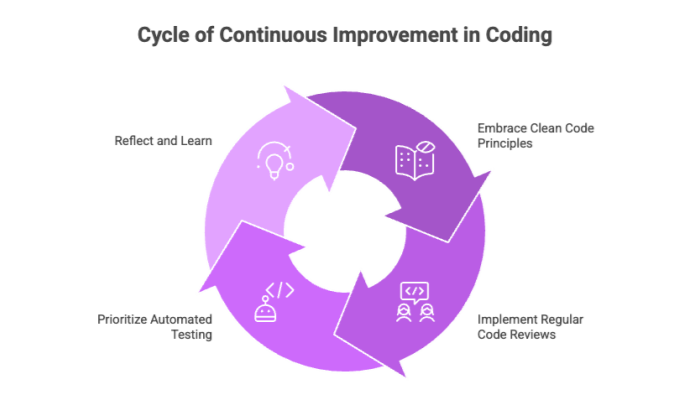

Common Challenges in the Coding Process
Developers often encounter obstacles like unclear requirements, which can hinder the coding process. Common challenges include debugging complex projects, managing technical debt, and balancing speed and quality. Addressing these challenges effectively is crucial for maintaining high code quality and ensuring the success of software projects.
Debugging Complex Issues
Debugging skills, logical and algorithmic thinking, and creativity are essential for effectively solving problems in coding. Attention to detail is crucial when it comes to identifying bugs in code. It is equally important for effectively fixing those issues. Effective debugging requires a combination of these skills and a systematic approach to identify and resolve issues.
Strategies for solving complex problems include breaking down the problem into smaller parts, using debugging tools, and collaborating with team members to gain different perspectives. Strong debugging skills enable developers to quickly identify and fix issues, ensuring the software remains functional and reliable.
Managing Technical Debt
Technical debt refers to the future costs and complications that arise from taking shortcuts and prioritizing immediate solutions over long-term quality. Technical debt accumulates when developers prioritize quick fixes over long-term solutions, potentially leading to increased future expenses. Implementing feedback loops, such as code reviews and retrospectives, allows teams to identify issues early and improve code quality effectively.
Addressing technical debt proactively is essential to prevent it from accumulating and slowing down future development. Regularly reviewing and refactoring code can help reduce technical debt and maintain a high level of code quality. Effective management of technical debt ensures that software remains maintainable and scalable in the long term.
Balancing Speed and Quality
Balancing speed with quality requires clear priorities to ensure critical features meet high standards without delays. In software development, it is crucial to balance speed with quality in order to meet tight deadlines without sacrificing the project’s integrity. Effective strategies for achieving balance can include regular code reviews, prioritization of automated testing, and adopting clean code principles.
Neglecting to balance speed and quality can lead to technical debt, increased defect rates, and ultimately, project failure. Strategies to balance speed and quality ensure that software meets high standards and is delivered on time.
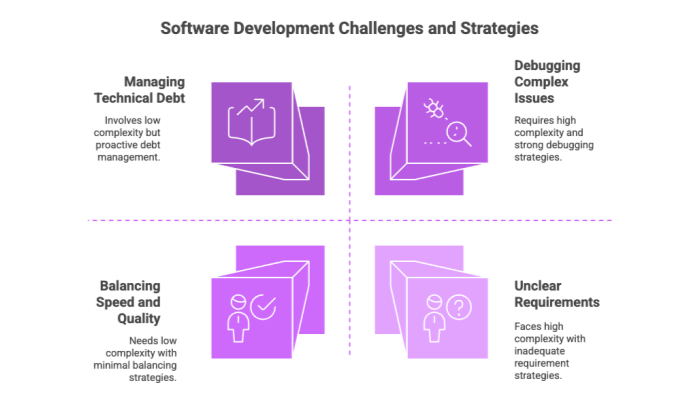

Role of Development Teams in the Coding Process
Development teams consist primarily of programmers, software engineers, and software developers, each contributing to different aspects of software development. Effective communication is vital among developers, project managers, and other stakeholders to facilitate successful collaboration during the coding process. The development team plays a crucial role in this dynamic.
Understanding team roles is critical for the smooth execution and success of software projects, ensuring that each member contributes effectively.
Programmers
Programmers are responsible for writing, debugging, and testing the code that forms the backbone of software applications. The main tasks of programmers include writing source code, debugging, and testing software. Version control systems, such as Git, enable teams to track and manage code changes efficiently, fostering collaboration and reducing conflicts in programming language.
Effective communication within teams can help mitigate rushed decisions that compromise code quality. Effective collaboration and the use of version control systems ensure that code is robust and maintainable, contributing to the overall success of the software project.
Software Engineers
Software engineers play a broader role in the software development process, encompassing designing, developing, testing, and maintaining software applications. They are responsible for ensuring that software meets user requirements and that different software components can interact seamlessly. This involves overseeing the creation and deployment of patches, updates, and new features.
Focusing on both technical and architectural aspects ensures that the software is scalable, maintainable, and efficient. Their role is critical in bridging the gap between design and implementation, ensuring that the software developed is of high quality and meets the needs of users and stakeholders.
Software Developers
Software developers have a project-based focus within the software development lifecycle. Their common tasks include:
-
Fixing errors
-
Working on software updates
-
Developing specific aspects of software. A software developer plays a crucial role in iterative development, ensuring that each iteration meets the project’s goals and user requirements. This software development work is essential for delivering high-quality products.
Focusing on specific project tasks lets software developers contribute to the continuous improvement and evolution of the software. Their work ensures that the software remains up-to-date with the latest features and fixes, meeting the changing needs of users and maintain software applications high standards of quality.
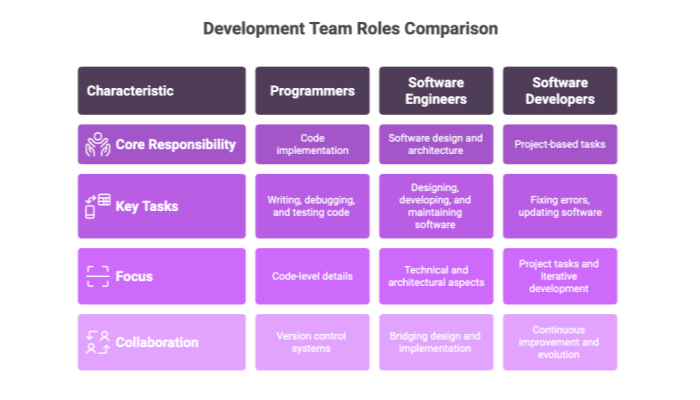

Tools and Technologies for Coding
The tools and technologies used in the coding process are essential for enhancing productivity and maintaining code quality. AI tools, for example, help developers proactively address issues with code and performance by analyzing large datasets to uncover patterns and anomalies. These tools can automate the remediation of errors and bugs, significantly improving the efficiency of the coding process.
Integrated Development Environments (IDEs)
Many modern IDEs utilize artificial intelligence to enhance the coding experience. AI-powered code generation tools integrated into IDEs can suggest the next line of code, improving the coding workflow and saving time for developers. These tools also automate repetitive coding tasks, enhancing productivity during cloud migration and other scenarios.
Using AI tools in IDEs provides significant benefits, such as improving the accuracy and efficiency of code generation. This allows developers to focus on more complex and creative aspects of coding, ultimately leading to higher quality software applications.
Version Control Systems
Version control systems are essential tools in software development that help manage changes to source code over time. By maintaining a history of changes, version control systems can be invaluable for debugging and understanding project evolution. They allow teams to manage multiple versions of a project, making it easier to revert to earlier states if necessary.
These systems facilitate collaboration among development teams, ensuring that code changes are tracked and managed efficiently. Version control systems help developers maintain high code quality and ensure that projects remain organized and manageable.
Code Analysis Tools
Code analysis tools offer several benefits:
-
Identify security vulnerabilities and performance issues, assisting developers in maintaining code quality.
-
Integrate with CI/CD pipelines, providing continuous feedback to developers during the coding process.
-
Static code analysis tools detect issues without executing the code, improving efficiency in identifying potential problems.
Some code analysis tools offer automated fixes, significantly reducing the time and effort developers spend on addressing problems. Using these tools ensures that code is secure, efficient, and high-quality, leading to more reliable software applications.
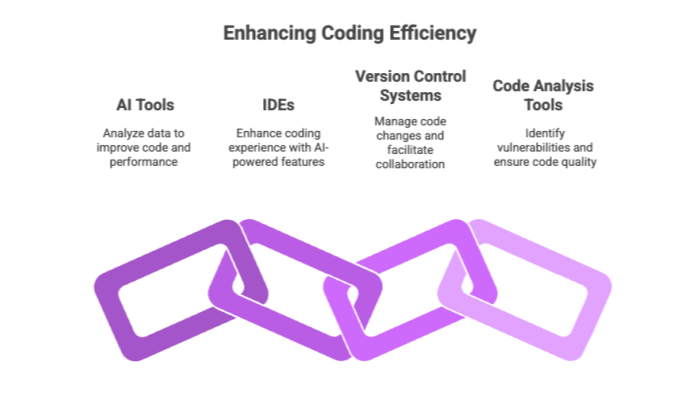

Measuring Code Quality
Measuring code quality is crucial for ensuring that high-quality products are delivered on time and within budget. Code analysis tools automate the review of code, helping identify bugs and security vulnerabilities before software deployment. These tools also provide metrics on code quality, allowing developers to identify areas for improvement.
Code Complexity Metrics
Code complexity metrics include:
-
Cyclomatic complexity: quantifies the number of independent paths through a program, indicating how difficult the code is to test and maintain.
-
Halstead complexity: measures the difficulty of understanding code based on its operators and operands, aiding in cognitive effort evaluation.
-
Lines of code: helps evaluate maintainability.
These metrics help assess the maintainability and understandability of code.
These metrics help development teams assess code complexity and identify areas needing refactoring or additional testing. This helps ensure that the code remains maintainable and easy to understand, reducing the likelihood of defects and improving overall software quality. Additionally, efficiency metrics lead time can provide valuable insights into the development process.
Defect Density
Defect density is a critical metric used to gauge code quality:
-
It indicates the prevalence of defects relative to the size of the codebase.
-
The calculation involves dividing the number of defects by the size of the code.
-
This highlights the quality of the software produced.
Tracking defect density allows development teams to identify patterns or areas in the code needing more rigorous testing or refactoring. This helps prioritize testing efforts and ensures that the most critical areas of the code are addressed, ultimately leading to more reliable and high-quality software.
Customer Satisfaction Metrics
Customer satisfaction metrics gather feedback on user experience, indicating how well the software meets user needs and expectations. Tools that measure customer satisfaction often include surveys and feedback forms, which provide insights into areas for improvement.
Measuring customer satisfaction measures customer satisfaction ensures that software meets user requirements and provides a positive user experience that aligns with customer expectations. This feedback is essential for guiding future development priorities and ensuring that the software continues to evolve in line with user needs.


Continuous Improvement in Coding
Continuous improvement is a fundamental principle in the software development process. Regularly assessing code quality and implementing improvements ensures that software remains robust and efficient.
Customer feedback can be instrumental for measuring software effectiveness and guiding improvements based on user support experience.
Refactoring
Refactoring is the process of restructuring existing computer code without changing its external behavior, aiming to improve nonfunctional attributes of the software. Improving code structure through refactoring leads to enhanced maintainability, readability, and reduces complexity in the codebase.
Regularly addressing technical debt is essential to prevent it from accumulating and slowing down future development. Effective refactoring can improve code quality, making it easier for teams to manage and evolve the software in future development cycles.
Learning and Development
Self-directed education in coding has become increasingly popular, allowing developers to learn at their own pace. The benefits of self-directed learning include flexibility, personalized learning paths, and the ability to focus on specific interests in coding. Utilizing online resources and communities significantly enhances the learning experience for aspiring developers.
Ongoing learning and skill development are crucial for adapting to the rapidly changing technology landscape in software development. Continuous skill improvement keeps developers updated with new technologies and best practices, enhancing coding abilities and contributing to project success.
Feedback Loops
Implementing regular feedback loops helps identify areas for improvement in coding practices. Regular feedback assists developers in refining their coding techniques and overall quality. Effective feedback mechanisms foster better collaboration among development teams.
Key benefits of regular feedback loops include:
-
Identifying areas for improvement in coding practices
-
Assisting developers in refining their coding techniques and overall quality
-
Fostering better collaboration among development teams
Incorporating feedback loops into the development process ensures continuous improvement in coding practices and prompt identification and resolution of issues. This leads to more efficient and effective software development and higher quality software products.
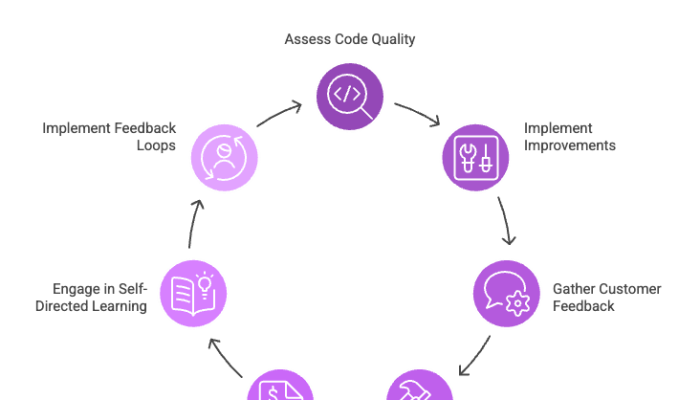

Summary
In mastering the software coding process, we have explored the critical stages, from setting up the development environment to continuous improvement.
By following best practices such as embracing clean code principles, implementing regular code reviews, and prioritizing automated testing, developers can ensure high code quality and efficient development processes. Addressing common challenges like debugging complex issues, managing technical debt, and balancing speed and quality is essential for maintaining robust and reliable software.
By understanding the roles within development teams and leveraging tools and technologies like IDEs, version control systems, and code analysis tools, developers can enhance their productivity and collaboration. Measuring code quality through metrics like code complexity, defect density, and customer satisfaction ensures that the software meets high standards and user expectations. Continuous improvement through refactoring, learning, and feedback loops is crucial for adapting to changing requirements and delivering high-quality software applications.
By applying these principles and practices, developers can master the software coding process and achieve success in their projects.

Frequently Asked Questions
Mastering the software coding process is fundamental to successful software development, enabling teams to deliver high-quality software applications that meet user needs and business goals. This process integrates various software development methodologies, including agile development and iterative development, which focus on continuous improvement and adaptability. By leveraging risk management strategies and operating systems compatibility, developers ensure seamless software integration and performance.
Key quality metrics such as defect density and customer satisfaction metrics guide the development team in maintaining code quality and optimizing customer support response time throughout the maintenance phase. Understanding these aspects is essential for effective software engineering and achieving the primary objective of creating reliable, efficient software systems.
What is the software coding process?
The software coding process involves converting design documents into functional code with programming languages to create efficient software that meets specified requirements. Following this structured approach ensures quality and adherence to project goals.
Why is setting up the development environment important?
Establishing the development environment is essential for optimizing the coding process, improving productivity, and ensuring high code quality. A well-configured environment facilitates effective development and minimizes potential setbacks.
What are the benefits of regular code reviews?
Regular code reviews enhance code quality and promote best practices while fostering collaboration and facilitating the early identification of potential issues. This practice ultimately leads to more efficient and effective development processes.
How does automated testing improve software quality?
Automated testing significantly enhances software quality by reliably identifying and fixing bugs, which facilitates continuous integration and minimizes the risk of introducing new issues.
What is defect density, and why is it important?
Defect density is a key metric that measures code quality by assessing the number of defects in relation to the size of the codebase. It is important because it aids in prioritizing testing efforts and addressing critical areas of the code effectively.


